

DRAG DROP -
Note: This question is part of a series of questions that use the same scenario. For your convenience, the scenario is repeated in each question. Each question presents a different goal and answer choices, but the text of the scenario is exactly the same in each question in this series.
You have a database named Sales that contains the following database tables: Customer, Order, and Products. The Products table and the Order table are shown in the following diagram.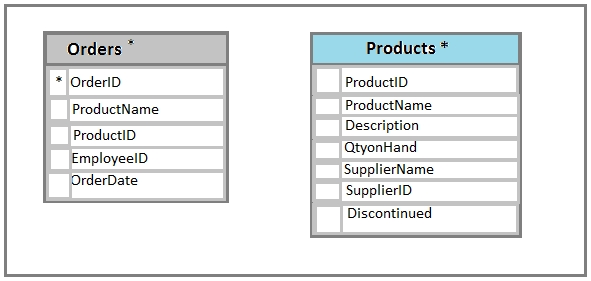
The customer table includes a column that stores the data for the last order that the customer placed.
You plan to create a table named Leads. The Leads table is expected to contain approximately 20,000 records. Storage requirements for the Leads table must be minimized.
Changes to the price of any product must be less a 25 percent increase from the current price. The shipping department must be notified about order and shipping details when an order is entered into the database.
You need to implement the appropriate table objects.
Which object should you use for each table? To answer, drag the appropriate objects to the correct tables. Each object may be used once, more than once, or not at all. You may need to drag the split bar between panes or scroll to view content.
Select and Place:
Correct Answer:

The Products table needs a primary key constraint on the ProductID field.
The Orders table needs a foreign key constraint on the productID field, with a reference to the ProductID field in the Products table.
HOTSPOT -
Note: This question is part of a series of questions that use the same scenario. For your convenience, the scenario is repeated in each question. Each question presents a different goal and answer choices, but the text of the scenario is exactly the same in each question in this series.
You have a database named Sales that contains the following database tables: Customer, Order, and Products. The Products table and the Order table are shown in the following diagram.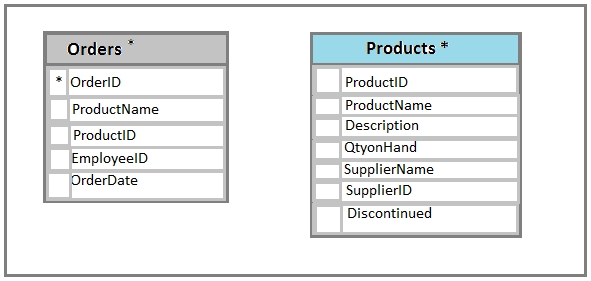
The customer table includes a column that stores the data for the last order that the customer placed.
You plan to create a table named Leads. The Leads table is expected to contain approximately 20,000 records. Storage requirements for the Leads table must be minimized.
You need to implement a stored procedure that deletes a discontinued product from the Products table. You identify the following requirements:
✑ If an open order includes a discontinued product, the records for the product must not be deleted.
✑ The stored procedure must return a custom error message if a product record cannot be deleted. The message must identify the OrderID for the open order.
What should you do? To answer, select the appropriate Transact-SQL segments in the answer area.
Hot Area: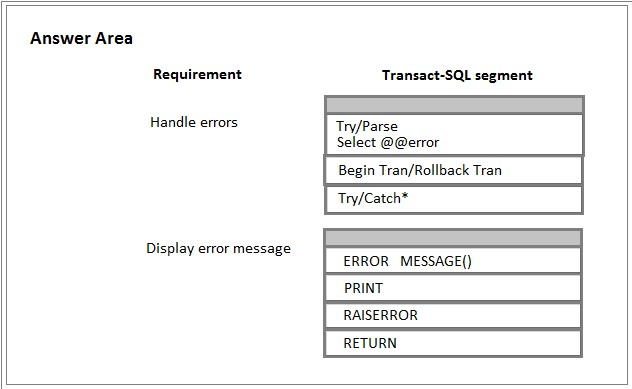
Correct Answer:
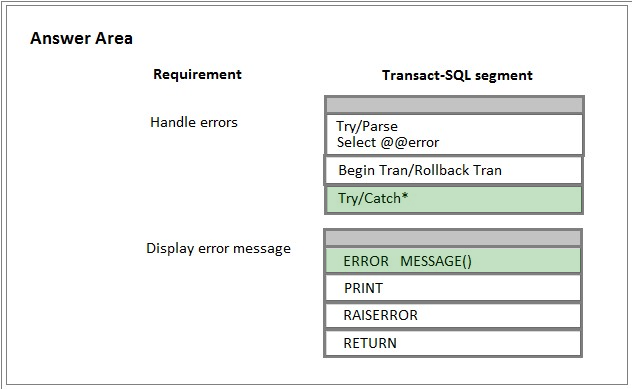
Using TRY...CATCH in Transact-SQL
Errors in Transact-SQL code can be processed by using a TRY"¦CATCH construct.
TRY"¦CATCH can use the following error function to capture error information:
ERROR_MESSAGE() returns the complete text of the error message. The text includes the values supplied for any substitutable parameters such as lengths, object names, or times.
References:
https://technet.microsoft.com/en-us/library/ms179296(v=sql.105).aspx
HOTSPOT -
Note: This question is part of a series of questions that use the same scenario. For your convenience, the scenario is repeated in each question. Each question presents a different goal and answer choices, but the text of the scenario is exactly the same in each question in this series.
You have a database named Sales that contains the following database tables: Customer, Order, and Products. The Products table and the Order table are shown in the following diagram.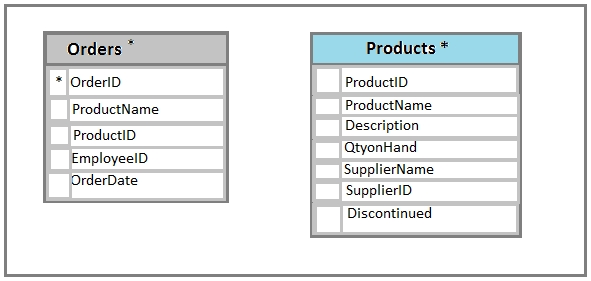
The customer table includes a column that stores the data for the last order that the customer placed.
You plan to create a table named Leads. The Leads table is expected to contain approximately 20,000 records. Storage requirements for the Leads table must be minimized.
You need to create triggers that meet the following requirements:
✑ Optimize the performance and data integrity of the tables.
✑ Provide a custom error if a user attempts to create an order for a customer that does not exist.
✑ In the Customers table, update the value for the last order placed.
✑ Complete all actions as part of the original transaction.
In the table below, identify the trigger types that meet the requirements.
NOTE: Make only selection in each column. Each correct selection is worth one point.
Hot Area: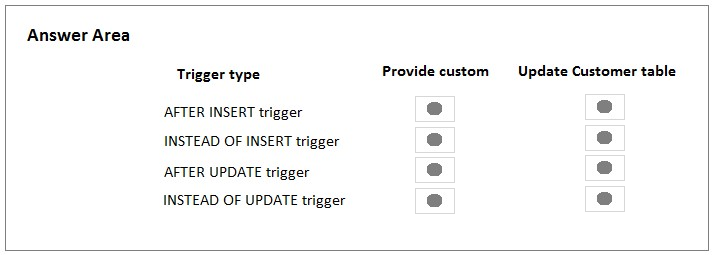
Correct Answer:
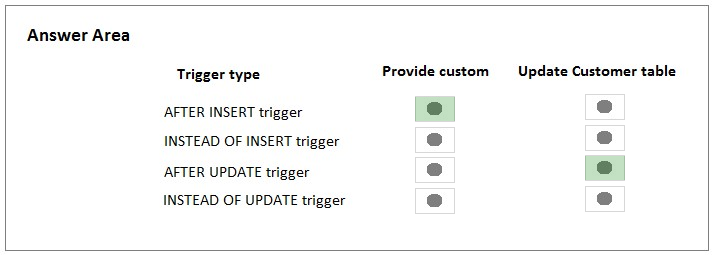
INSTEAD OF INSERT triggers can be defined on a view or table to replace the standard action of the INSERT statement.
AFTER specifies that the DML trigger is fired only when all operations specified in the triggering SQL statement have executed successfully.
References:
https://technet.microsoft.com/en-us/library/ms175089(v=sql.105).aspx
HOTSPOT -
Note: This question is part of a series of questions that use the same scenario. For your convenience, the scenario is repeated in each question. Each question presents a different goal and answer choices, but the text of the scenario is exactly the same in each question in this series.
You have a database named Sales that contains the following database tables: Customer, Order, and Products. The Products table and the Order table are shown in the following diagram.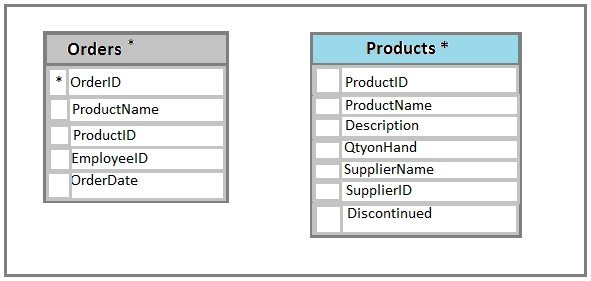
The customer table includes a column that stores the data for the last order that the customer placed.
You plan to create a table named Leads. The Leads table is expected to contain approximately 20,000 records. Storage requirements for the Leads table must be minimized.
The Leads table must include the columns described in the following table.
The data types chosen must consume the least amount of storage possible.
You need to select the appropriate data types for the Leads table.
In the table below, identify the data type that must be used for each table column.
NOTE: Make only one selection in each column.
Hot Area: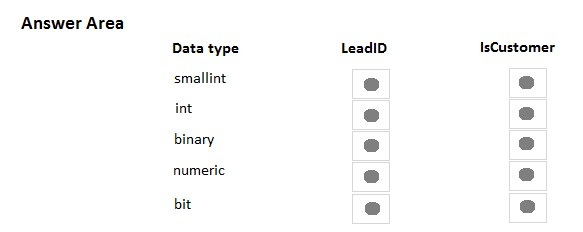
Correct Answer:
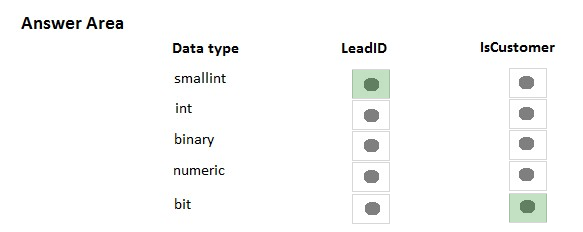
Bit is aTransact-SQL integer data type that can take a value of 1, 0, or NULL.
Smallint is a Transact-SQL integer data type that can take a value in the range from -32,768 to 32,767. int, bigint, smallint, and tinyint (Transact-SQL)
Exact-number data types that use integer data.
References:
https://msdn.microsoft.com/en-us/library/ms187745.aspx
https://msdn.microsoft.com/en-us/library/ms177603.aspx